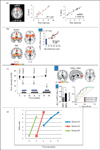Predicting transition to chronic pain
- PMID: 23823463
- PMCID: PMC4887742
- DOI: 10.1097/WCO.0b013e32836336ad
Predicting transition to chronic pain
Abstract
Purpose of review: Most individuals who develop pain following an inciting event will return to a healthy state as the injury heals. However, a small percentage continue to suffer, that is, transition to chronic pain. Chronic pain may persist for years and is accompanied by cognitive abnormalities, as well as diminished quality of life. In animals, persistent pain is characterized by peripheral and spinal cord reorganization, and recent evidence in humans also indicates cortical reorganization. Yet, despite more than 30 years of research, there is little agreement on the neural mechanisms that mediate the transition from acute to chronic pain.
Recent findings: In a longitudinal brain-imaging study, individuals who developed an intense back pain episode were followed over a 1-year period, during which pain and brain parameters were collected repeatedly. A smaller number of healthy individuals and chronic back pain patients were also studied concomitantly, as positive and negative controls. At the time of entry into the study, strength of synchrony between the medial prefrontal cortex and nucleus accumbens (i.e. functional connectivity) was predictive (>80% accuracy) of individuals who subsequently transition to chronicity 1 year later.
Summary: Properties of the brain's emotional learning circuitry predict the transition to chronic pain. The involvement of this circuitry in pain remains mostly unexplored. Future human and animal model studies are necessary to unravel underlying mechanisms driving pain chronicity, with the potential of advancing novel therapeutics for preventing pain chronification.
Conflict of interest statement
There are no conflicts of interest.
Figures


References
-
- Frymoyer JW. Back pain and sciatica. N Engl J Med. 1988;318:291–300. - PubMed
-
- Andersson GBJ, Frymoyer JW. The adult spine: principles and practice. Vol. 2. Philadelphia, PA: Lippincott-Raven; 1997. The epidemiology of spinal disorders; pp. 93–141.
-
- Hart LG, Deyo RA, Cherkin DC. Physician office visits for low back pain. Frequency, clinical evaluation, and treatment patterns from a U.S. national survey. Spine. 1995;20:11–19. - PubMed
-
- Praemer A, Furnes S, Rice DP. Musculoskeletal conditions in the United States. Vol. 1. Rosemont, IL: American Academy of Orthopaedic Surgeons; 1992. pp. 1–99.
-
- Deyo RA. Low-back pain. Sci Am. 1998;279:48–53. - PubMed
Publication types
MeSH terms
Grants and funding
LinkOut - more resources
Full Text Sources
Other Literature Sources
Medical
Research Materials

